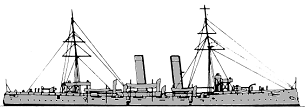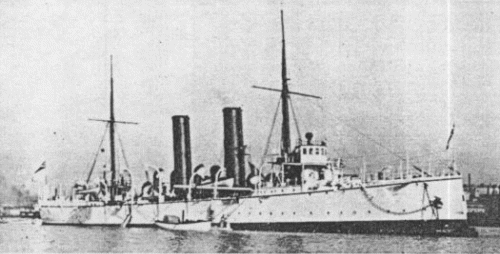

Sirius 1891
| Name | No | Yard No | Builder | Laid down | Launched | Comp | Fate |
| Rainbow | Palmer, Jarrow, UK | 30.12.1889 | 25.3.1891 | 1.1893 // 8.1910 | depot ship 1914 |
|
Displacement normal, t |
3600 |
|
Displacement full, t |
|
|
Length, m |
91.4 pp 95.7 oa |
|
Breadth, m |
13.3 |
|
Draught, m |
5.64 |
|
No of shafts |
2 |
|
Machinery |
2 3-cyl VTE, 3 double-ended and 2 single-ended cylindrical boilers |
|
Power, h. p. |
natural draught: 7000 forced draught: 9000 |
|
Max speed, kts |
natural draught: 18.5, forced draught: 19.7 |
|
Fuel, t |
coal 535 |
|
Endurance, nm(kts) |
8000(10) |
| Armour, mm | steel; deck: 51 - 32, gunshields: 114, engine hatch: 127, CT: 76 |
|
Armament |
2 x 1 - 152/40 QF Mk I/II, 6 x 1 - 120/40 QF Mk I/II/III/IV, 8 x 1 - 57/40 6pdr Hotchkiss Mk I, 1 x 1 - 47/40 3pdr Hotchkiss Mk I, 4 x 1 - 11.9/78, 4 - 356 TT (aw, 1 bow, 2 beam, 1 aft) |
|
Complement |
273 |
Project history: The 21 ships of this class
were provided under the Naval Defence Act of 1889. In design they were enlarged
versions of the Medea class with the main armament modified to mixed
calibre QF guns only. The two 152mm guns were placed on the centreline of the
forecastle and poop and the 120mm were mounted 3 on each side of the upper deck
amidships. The 57mm guns were all on the upper deck, 4 being amidships, between
the 120mm, and 2 forward and 2 aft firing through embrasured ports for ahead and
astern fire. The 120mm guns were not fitted on sponsons and the class were
severely criticised for their lack of ahead and astern fire and for lack of
gunpower generally in comparison to foreign cruisers of similar type. Two TT
were fitted broadside abreast the mainmast on the upper deck and could be
trained through an arc of 90°; one was carried in the bow, also on the upper
deck; and a stern tube was fitted at main deck level.
The engines, being vertical instead of horizontal, were
mounted side by side and separated from each other by a centreline bulkhead. The
after boiler room contained two double-ended boilers while the forward room
contained one double-ended and two single-ended boilers. Most of the class
achieved the designed speed on trial and they were generally regarded as good
steamers, and while several suffered early deterioration of their machinery and
consequent loss of speed many others proved capable of achieving their designed
speed until late in their careers. Ten of the class were sheathed in wood and
copper for tropical service which added 200t to the displacement and resulted in
a 0.3kt loss in designed speed.
Although larger than the Medea
class, the Apollos had the same layout with a turtle back forecastle and
a low freeboard, and although slightly better than their predecessors, they were
wet ships and poor sea boats which would have found great difficulty in fighting
their waist guns in a seaway.
Ship protection: The protective deck was 32mm thick on the flat and 51mm on the slope, and the engine cylinders, where they projected above this deck, were protected by a 127mm armoured glacis around the engine room hatch.
Modernizations: None.
Naval service: No significant events.

Rainbow as built
© Ivan Gogin, 2015